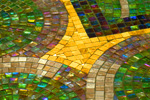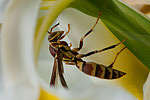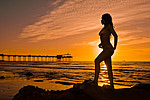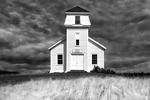Best entry-level DSLR Cameras
Also Ran
Pentax K-r
The Pentax K-r has a number of high-end features, like a very fast shutter speed of 1/6000, very good low light performance, and six frames per second continuous shooting, that make it very impressive on paper. It can mount any Pentax "K-mount" lens dating back to the 1970s. It even has in-body image stabilization, allowing it to reduce camera shake with any lens. On the other hand, some basic features that aren't on the spec sheet come up short. Image stabilization isn't as solid as Canon or Nikon's offerings, while video is limited to 720p. The in-body AF motor is a touch slower than the in-lens offerings from Canon and Nikon.
Pros:
- 6 FPS continuous shooting for fast action
- In-body image stabilization
- 100-25600 ISO range for low-light shooting
- Can mount any K-mount lens
Cons:
- Highlights tend to clip in high-contrast scenes
- Video performance is lacking
- Slower autofocus
- More limited lens lineup
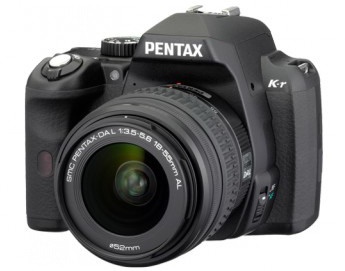
The Good
Fast continuous mode. The K-r will rock out six frames per second at maximum resolution, up to a maximum of 12 frames RAW or 29 frames JPG. This is twice as fast as the Nikon D3100 and half again as fast as both Canon models. Continuous mode is useful whenever a subject is in motion, like sporting events or wildlife photography (especially birds). By the time you figure out whether or not you got the picture you wanted, the subject is usually gone. So instead of shooting, checking, and shooting again, just hold down the button until the buffer is full or the subject is gone and then pick the best of the batch when you get home. It's not elegant, but it is effective.
Extended low light performance. On a camera, ISO is a measure of the sensitivity of the image sensor. Higher ISO means that the sensor requires less light to make an image, usually at the cost of more grainy digital noise. The K-r offers ISO ratings up to 25600, which is one full stop above the 12800 offered by other cameras in the shootout. A full explanation of stops and ISO rating progression is beyond the scope of this article, but suffice it to say that the K-r can capture some shots that other cameras cannot.
On the other hand, the K-r shows a bit more image noise at the lower ISO levels most people will typically use, and the amount of digital noise at 12800 and 25600 ISO is pretty extreme. Think of these as "emergency" modes; they are useful when you absolutely need them, but should be avoided when possible.
In-body image stabilization. When you hold a camera, your hands shake. That's just a fact. The longer the shutter is open, the more likely that the natural shake of your hands will show up in the picture, blurring the image. Image stabilization is a way for the camera to stabilize itself, resulting in less blurring. All of today's cameras have image stabilization, but the big difference is that Canon and Nikon's image stabilization is built into the lens while Pentax's system is in the camera body itself. This means the K-r can stabilize any lens you want to use, including any old manual lenses you happen to have lying around. We did some shooting with the K-r and an old manual focus lens from the 1970s and it was great fun.
The Bad
Image quality. Okay, so image quality on the K-r isn't bad, per se. But when you look at images from the Pentax K-r compared to images from the Canon Rebel T3, there's not a huge quality difference.
The K-r looks a touch underexposed, but the T3 looks a touch overexposed. Neither has a real advantage in sharpness or detail. For a $100 increase in price, you'd expect the K-r to show some kind of advantage.
Clipped highlights. In especially high-contrast scenes, where the K-r cannot capture the entire scene properly, it tends to clip highlights (the bright parts of the picture) instead of shadows. This is a problem because, the way cameras work these days, most of the detail is captured in the highlights, and unless you're going for something specifically artistic, the shadows tend to be less important. If you are concerned about losing highlight detail, you can use the camera's exposure compensation system to bring exposure down a touch, or you can bracket your shot - in essence, take several shots at different exposure settings to ensure you get one that you like.
Video. When it comes to video, the K-r comes up short. The camera is limited to 720p resolution, for one, putting it a step behind the D3100 and T2i. It also uses the Motion JPG format, which is a space hog and can be hard to work with depending on your computer. The other cameras in the shootout use H.264, which is much more space-efficient. There's no direct movie button, so you'll have to switch the mode dial before entering video mode. Moreover, there is no way to adjust exposure once you are actually shooting - you're locked at whatever settings the camera had before you started. There's no external microphone port, and the camera lacks an HDMI output, so you can't just hook it to your television or projector and play back your footage. All in all, working with the K-r for video can be more trouble than it's worth.
Slower Autofocus. The K-r's in-body autofocus motor tends to focus a little more slowly than the in-lens autofocus motors of the Canon and Nikon models. It's still quite fast compared to a point-and-shoot, though.
Limited lens lineup. Pentax has a fine selection of lenses for beginners, and even a few more expensive lenses that cater to professionals. But the lens lineup is simply not as extensive as that of Canon or Nikon, and that is why it is so rare to see professional photographers shooting Pentax. If you plan on making photography into a serious hobby or a business and know that you'll be buying more equipment down the line, it is worth considering the rest of a manufacturer's lineup before taking the plunge. With Pentax, the available selection just isn't as good.
The Verdict
Pentax is a company with a long history in the photography world, and a lot of people have good feelings towards Pentax thanks to their series of film SLRs. Indeed, I myself learned to shoot on a Pentax K1000, the quintessential student camera. Though today's Pentax bears little, if any, resemblance to the Pentax of yesteryear, they still know how to make a camera. The K-r is a solid DSLR for still photos, though video performance comes up lacking. Some of the most impressive features on paper don't directly translate to a higher quality camera, but overall the K-r is a competent performer.
In This Shootout:
Shootout
Canon Rebel T2i
Find out why the Canon Rebel T2i is the Best Entry-Level DSLR Camera
Nikon D3200
The Nikon D3200 is a close second for stills and video
Nikon D3100
The Nikon D3100 comes in third place
Pentax K-r
The K-r's fast continuous shooting make it a good option for sports and wildlife
Canon T3
The T3 is the most budget-friendly option, but comes up short on features
Advice and Conclusion
Some advice to first-time buyers of DSLR Cameras

